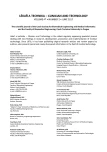RESPIRATORY SOUNDS AS A SOURCE OF INFORMATION IN ASTHMA DIAGNOSIS
Around 300 million people all over the world at all age level suffer from asthma [1]. Patients with this disease have primarily difficult breathing with wheezing in respiratory sounds, cough and feeling of constricted chest. Therefore their physical activity is strongly limited [2]. Nowadays, there are several methods for asthma diagnosis, for example spirometry, measuring of peaks of expiratory velocity or measuring of bronchial reactivity. Although these methods are sufficiently reliable in most cases, they have also some imperfections, which are obvious especially by diagnosing of badly collaborating patients, e.g. small children aged up to three years. These infants can’t provide operations required for diagnosis, so results performed diagnosis are not reliable. For this reason, there is an idea of developing non invasive method of asthma diagnosis and other pulmonary diseases that would not need collaboration of patient [3]. One of the most probably working usable principles is comparison of air flow in airways of healthy and ill person. The difference of the air flow is caused by bronchial obstruction and constriction of airways of patient. There are other sounds and wheezing in the respiratory sounds detectable during breathing as a typical manifestation of the disease [4]. These phenomena can be detected by hearing of sound or by harmonic analysis.
Keywords:
asthma, air flow, wheezing, harmonic analysis, Fourier transform, inspiratory phase, expiratory phase
Autoři:
D. Skalicky 1,3; F. Lopot 1,3; V. Koucky 2; P. Kubovy 1; P. Pohunek 2; V. Zoul 3; K. Jelen 1; V. Dynybyl 3
Působiště autorů:
Faculty of sports and physical education, Charles University in Prague, Czech Republic
1; Department of pneumology, University Hospital Motol, Prague, Czech Republic
2; Faculty of Mechanical Engineering, Czech Technical University in Prague, Czech Republic
3
Vyšlo v časopise:
Lékař a technika - Clinician and Technology No. 2, 2017, 47, 56-59
Kategorie:
Původní práce
Souhrn
Around 300 million people all over the world at all age level suffer from asthma [1]. Patients with this disease have primarily difficult breathing with wheezing in respiratory sounds, cough and feeling of constricted chest. Therefore their physical activity is strongly limited [2]. Nowadays, there are several methods for asthma diagnosis, for example spirometry, measuring of peaks of expiratory velocity or measuring of bronchial reactivity. Although these methods are sufficiently reliable in most cases, they have also some imperfections, which are obvious especially by diagnosing of badly collaborating patients, e.g. small children aged up to three years. These infants can’t provide operations required for diagnosis, so results performed diagnosis are not reliable. For this reason, there is an idea of developing non invasive method of asthma diagnosis and other pulmonary diseases that would not need collaboration of patient [3]. One of the most probably working usable principles is comparison of air flow in airways of healthy and ill person. The difference of the air flow is caused by bronchial obstruction and constriction of airways of patient. There are other sounds and wheezing in the respiratory sounds detectable during breathing as a typical manifestation of the disease [4]. These phenomena can be detected by hearing of sound or by harmonic analysis.
Keywords:
asthma, air flow, wheezing, harmonic analysis, Fourier transform, inspiratory phase, expiratory phase
Zdroje
[1] TEŘL, Milan a Petr POHUNEK (eds.).: Strategie diagnostiky, prevence a léčby astmatu: uvedení globální strategie do praxe v ČR. Vyd. 1. Praha: Jalna, 2012.
[2] AYRES, Jon G.: Astma. 1. vyd. Praha: Grada, 2001. Informace a rady lékaře. ISBN 80-247-0091-3.
[3] SKALICKÝ, David.: Využití elektronického fonendoskopu v diagnostice astmatu. ČVUT, Praha, 2016.
[4] PASTERKAMP, Hans, Steve S. KRAMAN a George R. WODICKA. Respiratory Sounds. American Journal of Respiratory and Critical Care Medicine. 1997, ISSN 1073-449x.
[5] SYROVÝ, Václav.: Hudební akustika. 3., dopl. vyd. v Praze: Akademie múzických umění, 2013. ISBN 978-80-7331-297-8.
[6] BECK, Raphael, Nael ELIAS: Computerized acoustic assessment of treatment efficacy of nebulized epinephrine and albuterol in RSV bronchiolitis. BMC Pediatrics. 2007, ISSN 14712431.
[7] FISCHER, Hendrik Stefan, Lia Carlotta PUDER: Relationship between computerized wheeze detection and lung function parameters in young infants. Pediatric Pulmonology. 2015.
[8] KRAMAN, S. S.: Comparison of lung sound transducers using a bioacoustic transducer testing system. Journal of Applied Physiology. 2006, ISSN 8750-7587.
Štítky
BiomedicínaČlánok vyšiel v časopise
Lékař a technika

2017 Číslo 2
Najčítanejšie v tomto čísle
- /GD-TRACKER/ A SOFTWARE FOR BLOOD-BRAIN BARRIER PERMEABILITY ASSESSMENT
- PERISTALTIC FLOW OF LITHOGENIC BILE IN THE VATERI’S PAPILLA AS NON-NEWTONIAN FLUID IN THE FINITE-LENGTH TUBE: ANALYTICAL AND NUMERICAL RESULTS FOR REFLUX STUDY AND OPTIMIZATION
- RESPIRATORY SOUNDS AS A SOURCE OF INFORMATION IN ASTHMA DIAGNOSIS
- MEASUREMENT OF THE VALUES OF RADIOFREQUENCY ELECTROMAGNETIC FIELDS AROUND THE HEAD OF ADOLESCENTS
